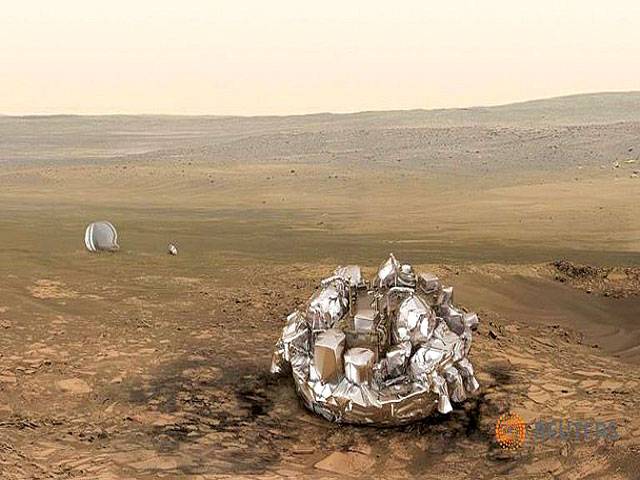FRANKFURT-Images taken by a NASA Mars orbiter indicate that Europe’s ill-fated Mars lander left a small crater on the Red Planet’s surface, backing up scientists’ theory that the craft hit the ground at high speed.
The disc-shaped, 577-kg (1,272 lb) Schiaparelli probe, part of the Russian-European ExoMars programme to search for evidence of life on Mars, was destroyed last week when its thrusters stopped firing too soon during its descent to the surface.
It was only the second European attempt to land a craft on Mars, after a failed mission by the British craft Beagle 2 in 2003, and was designed to test technologies for a rover.
Scientists believe that the Schiaparelli lander plummeted to the ground from a height of 2 to 4 km (1.2 to 2.5 miles), hitting the ground at more than 300 km/h instead of touching down softly as it was supposed to.
New high-resolution pictures taken by the US Mars Reconnaissance Orbiter show a dark spot at the crash site, 2.4 m across, which the European Space Agency (ESA) said was consistent with a crater made by an object of the lander’s size crashing at a speed of several hundred kilometres per hour.
ESA’s scientists estimate that the crater is about 50 cm deep but are hoping for more details from further images to be taken by NASA’s orbiter in the coming weeks, ESA said in a statement published late on Thursday.
But the space agency said NASA’s images also showed asymmetric dark markings around the crash site that were more difficult to interpret.
“In the case of a meteoroid hitting the surface at 40,000-80,000 km/h, asymmetric debris surrounding a crater would typically point to a low incoming angle, with debris thrown out in the direction of travel,” it said in a statement.
Schiaparelli was travelling much slower than a meteoroid would, having used a heat shield and parachute to slow down after entering the atmosphere of Mars, and should have been descending almost vertically.
One possible explanation is that the lander’s fuel tanks could have exploded in one direction, throwing debris from the planet’s surface.
It is still unclear why the lander’s thrusters stopped firing sooner than expected. ESA said a report of investigators’ findings was likely to be finished no later than mid-November.
Landing on Mars, Earth’s neighbour and at its closest some 35 million miles (56 million km) away, is a notoriously difficult task that has thwarted most Russian efforts and given NASA trouble as well.
The primary part of the ExoMars mission has, however, been a success so far, as the Schiaparelli lander’s mothership has been brought into orbit around Mars, from where it will try to sniff out methane and other gases that might indicate the presence of life. It will also act as a data relay station for the rover, which is due to follow in 2020.






